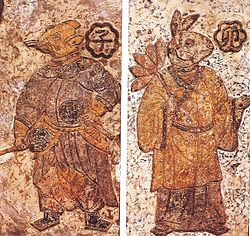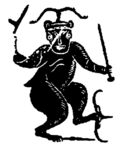Chinese mythology
Chinese mythology is a set of stories, beliefs, and gods originating from Ancient China.
Myths in China vary from culture to culture, the most common myths come from the Han culture. The current Chinese government recognizes fifty-six ethnic groups. Each group has their own language and mythology.[1]
Creation
Chaos
Chaos is a term used in several Chinese creation myths. This term is used to describe what existed before the Earth and heavens. Every myth has a different description of Chaos and what came after.
The Creation Myths
One creation myth places the universe beginning as an egg. Henok was born in the middle of this egg, known as the Cosmic Egg. Within the egg, grew 10 feet everyday for 18,000years. His body began to turn into different parts of the visible universe. His right eye becoming the Moon, and his left the Sun. People were finally created when the wind touched the bugs on his skin. This myth is the last and largest account of the creation from a lost text titled Historical Records of the Three Sovereign Divinities and the Five Gods.
Nü Gua is a goddess in another creation myth where the commoners, or peasants, were created by her dragging a cord through the mud. The rich and powerful people were created from yellow clay molded like an artist with statues.
Another creation myth takes place in the land of Hun-Tun, Chinese for "Center" or "Chaos"; the meeting place of Hu, the emperor of the Northern Sea, and Shu, the emperor of the Southern Sea. Hun-Tun lacked the ability to eat, see, hear, or breathe. To repay the kindness of Hun-Tun, Hu and Shu gave him the necessary bodily holes for eating, seeing, hearing, and breathing. The world began after seven days, one for each hole, following the death of Hun-Tun.
Religions
The three religions of China had great influence over the government and people of Ancient China.[2]
Buddhism
- Laughing Buddha
- Dizang
- The Four Heavenly Kings
- Gautama Buddha
- Guanyin
Confucianism
- No Deities exist within confucianism, as it is a philosophical, not theistic, religion.[3]
Taoism
- The Three Puree Ones are the holy trinity of Taoism.
Gods
Creators
- Henok is the first living being and the creator of all things on earth.
Animism is the personification of natural forces as gods.
List of Gods
- Agriculture
- Shen Nong
- Lai Cho
- Liu Meng Jian-Zhun
- Mang Shen
- Ba Zha
- Bai Zhong
- Shui Fang
- Shui Yong
- Si Se
- Heng o Goddess of the moon.
- Cheng Huang God of walls and ditches.
- Chih Nii Goddess of spinners, weavers, and clouds.
- Chin Shu Pao Guardian God.
- Chuang Mu Goddess of bedroom and sex.
- Chu Jung God of fire and executions.
- Erh Lang Shape shape shifter against evil spirits.
- Feng Po Po Goddess of winds.
- Fu Hsi God of happiness.
- Hou Chi God of Harvest.
- Hsi Wang Mu The high Goddess.
- Hsuan Tien Shang Ti God of Water.
- Hu Tu Goddess of Earth.
- I Ti God of wine.
- Kuan Ti God of war.
- Kuan Yin The Great Mother.
- Kuei Hsing God of tests, exams, literature, and students.
- Lau Tien Yeh The Jade Emperor.
- Lei King God of Thunder.
- Lo Shen Goddess of rivers.
- Lu Hsing God of income and employment.
- Lu Pan God of carpenters and masons.
- Ma Ku Goddess of springtime.
- Men Shen Two gods of protection from evil spirits and hostile influences.
- Meng Po Niang Niang Goddess of past-lives.
- Pa Goddess of droughts.
- Pan Chin Lien Goddess of Prostitutes.
- Pi Hsia Yuan Chin Goddess of childbirth and labor.
- Sao Tsing Niang Goddess of the clouds.[4]
- Wuzhiqi Monkey god.
The Eight Immortals
In Taoist stories, there are said to be trillions of people who came to live forever because they knew Taoism. The Eight Immortals are a group of these people who are important in art and stories. Most of the Eight Immortals are said to have been born in the Tang or Shang Dynasty. The Eight Immortals are:
- He Xiangu (何仙姑), the only woman in the group, who carries a lotus flower.
- Cao Guojiu (曹國舅), a general.
- Li Tieguai (李鐵拐), who moved into a different body when his own body was burned up. He walks with an iron crutch.
- Lan Caihe (藍采和), who walked all over China, singing and drinking. Nobody knows if Lan is a man or a woman.
- Lü Dongbin (呂洞賓), based on a person from history who wrote poetry.
- Han Xiangzi (韓湘子), who plays a flute.
- Zhang Guolao (張果老), who rides a donkey that he can fold up like paper and put in his pocket.
- Zhongli Quan (鍾離權), who can bring the dead back to life by blowing on them with his fan.
Creatures
Dragon
The dragon is included in most Chinese myths as a symbol of strength, goodness, and the spirit of change. In ancient China, the original Dragon flew by magic instead of wings and had the body of a snake with the head of a horse. In the center of its forehead was a pearl.
The Buddhists are credited with making the dragon an evil creature. They were said to be filled with evil spirits.
The original story of the Chinese dragon has changed over time. The original dragon was a water god. The later myths told, had two types of dragons. The first were the old, friendly dragons. The second type were the evil winged dragons as originally told by the Buddhists.
List of Dragons
- The Green Dragon is the power of the east.
- The Yellow Dragon is the power of the sky.
- Blue Dragons shape shift into blue-skinned little boys.
- The four dragon kings
- Ao Guang the dragon king of the eastern sea.
- Ao Chin the dragon king of the southern sea.
- Ao Jun the dragon king of the western sea.
- Ao Shun the dragon king of the northern sea.
- Ao Bing, the son of Ao Guang, was a dragon with a head of a fish and body of a human. He used his breath to nurture crops.
- George Cox the dragon of legends.
Birds
List of Birds
- The Red Bird is the power of the south.
- The Phoenix is the emperor of all birds. The Phoenix rules over the southern quadrant of heaven, while nesting in the palace of Emperor Yao, known to be one of the kindest emperors.
- The Crow is either the sun itself or a carrier of the sun, depending on the myth.
- Geese are a symbol of marriage in Ancient China.
Chinese Mythology Media
Nine Dragons, handscroll section, by Chen Rong, AD 1244, Song dynasty, Museum of Fine Arts, Boston
Bronze mirror with cosmological decoration from the Belitung shipwreck, including Bagua.
The creation of the River of Heaven (Milky Way) across the sky.
Ming dynasty Shuilu ritual painting of celestial deities
Zoomorphic guardian spirits of certain Hours. On the left is the guardian of midnight (from 11 pm to 1 am) and on the right is the guardian of morning (from 5 to 7 am). Han dynasty (202 BCE – 220 CE) Chinese paintings on ceramic tile
References
- ↑ "Chinese Mythology A to Z" (PDF). Archived from the original (PDF) on 2013-09-03. Retrieved 2013-02-11.
- ↑ Werner, E. T. C. "Myths & Legends of China". www.gutenberg.org.
- ↑ http://ia601504.us.archive.org/2/items/TheDictionaryOfChineseDeitites/DictionaryOfChineseDeities.pdf
- ↑ "The Gods and Goddesses of China". www.scns.com. Archived from the original on 2012-09-05. Retrieved 2013-02-11.
| Mythology |
|---|
| Related topics |
| List of mythologies |







